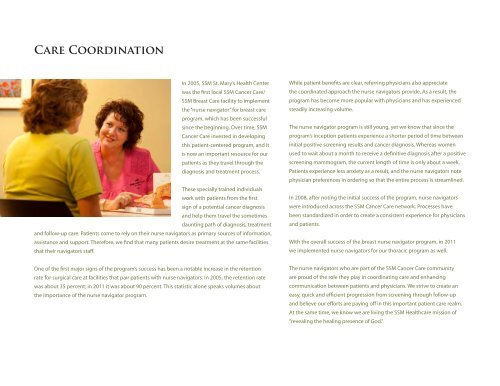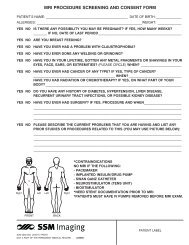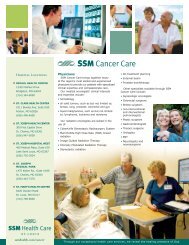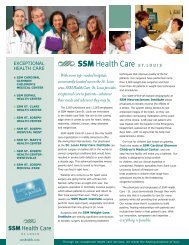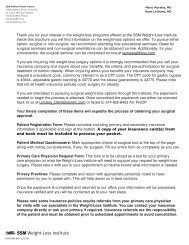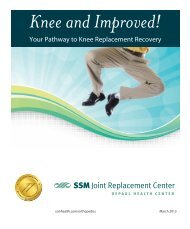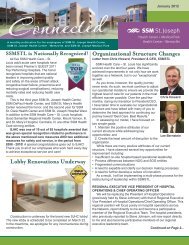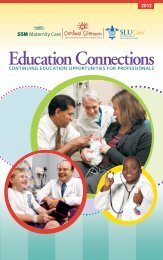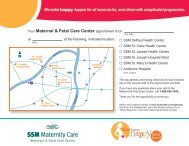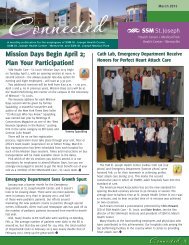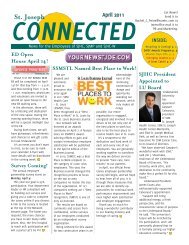Clinical Quality Measures Report - SSM Health Care St. Louis
Clinical Quality Measures Report - SSM Health Care St. Louis
Clinical Quality Measures Report - SSM Health Care St. Louis
Create successful ePaper yourself
Turn your PDF publications into a flip-book with our unique Google optimized e-Paper software.
<strong>Care</strong> Coordination<br />
In 2005, <strong>SSM</strong> <strong>St</strong>. Mary’s <strong>Health</strong> Center<br />
was the first local <strong>SSM</strong> Cancer <strong>Care</strong>/<br />
<strong>SSM</strong> Breast <strong>Care</strong> facility to implement<br />
the “nurse navigator” for breast care<br />
program, which has been successful<br />
since the beginning. Over time, <strong>SSM</strong><br />
Cancer <strong>Care</strong> invested in developing<br />
this patient-centered program, and it<br />
is now an important resource for our<br />
patients as they travel through the<br />
diagnosis and treatment process.<br />
These specially trained individuals<br />
work with patients from the first<br />
sign of a potential cancer diagnosis<br />
and help them travel the sometimes<br />
daunting path of diagnosis, treatment<br />
and follow-up care. Patients come to rely on their nurse navigators as primary sources of information,<br />
assistance and support. Therefore, we find that many patients desire treatment at the same facilities<br />
that their navigators staff.<br />
While patient benefits are clear, referring physicians also appreciate<br />
the coordinated approach the nurse navigators provide. As a result, the<br />
program has become more popular with physicians and has experienced<br />
steadily increasing volume.<br />
The nurse navigator program is still young, yet we know that since the<br />
program’s inception patients experience a shorter period of time between<br />
initial positive screening results and cancer diagnosis. Whereas women<br />
used to wait about a month to receive a definitive diagnosis after a positive<br />
screening mammogram, the current length of time is only about a week.<br />
Patients experience less anxiety as a result, and the nurse navigators note<br />
physician preferences in ordering so that the entire process is streamlined.<br />
In 2008, after noting the initial success of the program, nurse navigators<br />
were introduced across the <strong>SSM</strong> Cancer <strong>Care</strong> network. Processes have<br />
been standardized in order to create a consistent experience for physicians<br />
and patients.<br />
With the overall success of the breast nurse navigator program, in 2011<br />
we implemented nurse navigators for our thoracic program as well.<br />
One of the first major signs of the program’s success has been a notable increase in the retention<br />
rate for surgical care at facilities that pair patients with nurse navigators. In 2005, the retention rate<br />
was about 35 percent; in 2011 it was about 90 percent. This statistic alone speaks volumes about<br />
the importance of the nurse navigator program.<br />
The nurse navigators who are part of the <strong>SSM</strong> Cancer <strong>Care</strong> community<br />
are proud of the role they play in coordinating care and enhancing<br />
communication between patients and physicians. We strive to create an<br />
easy, quick and efficient progression from screening through follow-up<br />
and believe our efforts are paying off in this important patient care realm.<br />
At the same time, we know we are living the <strong>SSM</strong> <strong>Health</strong>care mission of<br />
“revealing the healing presence of God.”


